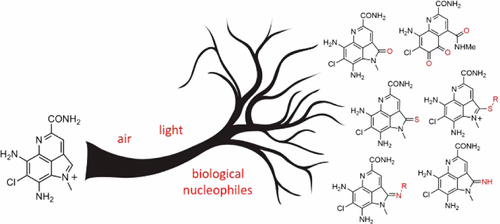当前位置:
X-MOL 学术
›
J. Nat. Prod.
›
论文详情
Our official English website, www.x-mol.net, welcomes your
feedback! (Note: you will need to create a separate account there.)
Thiol-Based Probe for Electrophilic Natural Products Reveals That Most of the Ammosamides Are Artifacts
Journal of Natural Products ( IF 3.3 ) Pub Date : 2017-01-05 00:00:00 , DOI: 10.1021/acs.jnatprod.6b00773
Daniela Reimer 1 , Chambers C. Hughes 1
Journal of Natural Products ( IF 3.3 ) Pub Date : 2017-01-05 00:00:00 , DOI: 10.1021/acs.jnatprod.6b00773
Daniela Reimer 1 , Chambers C. Hughes 1
Affiliation

|
To date, 16 members of the ammosamide family of natural products have been discovered, and except for ammosamide D each of these metabolites is characterized by an unusual chlorinated pyrrolo[4,3,2-de]quinoline skeleton. Several ammosamides have been shown to inhibit quinone reductase 2, a flavoenzyme responsible for quelling toxic oxidative species in cells or for killing cancer cells outright. Treatment of the extract from an ammosamide-producing culture (Streptomyces strain CNR-698) with a thiol-based reagent designed to label electrophilic natural products produced an ammosamide C-thiol adduct. This observation led us to hypothesize, and then demonstrate through experimentation, that all of the other ammosamides are derived from ammosamide C via nonenzymatic processes involving exposure to nucleophiles, air, and light. Like many established electrophilic natural products, reaction with the thiol probe suggests that ammosamide C is itself an electrophilic natural product. Although ammosamide C did not show substantial cytotoxicity against cancer cells, its activity against a marine Bacillus bacterial strain may reflect its ecological role.
中文翻译:

基于硫醇的亲电子天然产物探针表明大多数氨酰胺都是人工制品
迄今为止,已经发现了氨酰胺自然产物家族的16个成员,除氨酰胺D以外,每种代谢物的特征都是不寻常的氯化吡咯并[4,3,2- de ]喹啉骨架。几种氨酰胺已显示出抑制醌还原酶2的作用,黄酮酶可抑制细胞中的毒性氧化物质或直接杀死癌细胞。产氨酰胺培养物(链霉菌属)提取物的处理菌株CNR-698)与基于硫醇的试剂一起设计以标记亲电子的天然产物,从而产生了氨酰胺C-硫醇加合物。该观察结果使我们做出假设,然后通过实验证明,所有其他氨酰胺都是通过涉及暴露于亲核试剂,空气和光线的非酶过程从氨酰胺C衍生而来的。像许多已建立的亲电子天然产物一样,与硫醇探针的反应表明氨酰胺C本身就是亲电子天然产物。尽管氨酰胺C并未显示出对癌细胞的实质性细胞毒性,但其对海洋芽孢杆菌属菌株的活性可能反映了其生态作用。
更新日期:2017-01-05
中文翻译:

基于硫醇的亲电子天然产物探针表明大多数氨酰胺都是人工制品
迄今为止,已经发现了氨酰胺自然产物家族的16个成员,除氨酰胺D以外,每种代谢物的特征都是不寻常的氯化吡咯并[4,3,2- de ]喹啉骨架。几种氨酰胺已显示出抑制醌还原酶2的作用,黄酮酶可抑制细胞中的毒性氧化物质或直接杀死癌细胞。产氨酰胺培养物(链霉菌属)提取物的处理菌株CNR-698)与基于硫醇的试剂一起设计以标记亲电子的天然产物,从而产生了氨酰胺C-硫醇加合物。该观察结果使我们做出假设,然后通过实验证明,所有其他氨酰胺都是通过涉及暴露于亲核试剂,空气和光线的非酶过程从氨酰胺C衍生而来的。像许多已建立的亲电子天然产物一样,与硫醇探针的反应表明氨酰胺C本身就是亲电子天然产物。尽管氨酰胺C并未显示出对癌细胞的实质性细胞毒性,但其对海洋芽孢杆菌属菌株的活性可能反映了其生态作用。































 京公网安备 11010802027423号
京公网安备 11010802027423号